Rehabilitated penguins
New Zealand fur seal
The New Zealand fur seal - kekeno in Maori – is the most common seal in New Zealand.
Other species of seals seen in New Zealand are: the NZ sea lion (rapoka/whakahao), the leopard seal and the southern elephant seal.
NZ fur seals belong to the family of pinnipeds. There is 3 families of pinnipeds: true seals (leopard seals, elephant seals), eared seals (fur seals, sea lions) and walruses.
How can we make the difference between a NZ fur seal and a NZ sea lion?
Both species belong to the eared seals family. Eared seals feature external ears, hind flippers which can rotate forward allowing them to move fast on the land and no fur on the underside of their flippers. NZ fur seals can be differentiated from the NZ sea lions by:
- Their size: NZ fur seals are smaller
- Their pointy nose
- NZ fur seals prefer rocky shoreline while NZ sea lions are found mostly on sandy beaches.
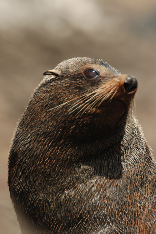
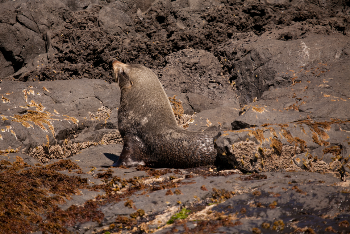
NZ fur seals have ears, a pointy nose, hind flippers and prefer a rocky shoreline
(Photo by Pohatu Penguins)
Where can we see NZ fur seals in New Zealand?
NZ fur seals are found on rocky shorelines on the mainland and off shore islands, such as the Chatham Islands and Sub-Antarctic islands. The breeding colonies range from the North Island (as far north as the Coromandel) to the South (as far south as the Sub-Antarctic Islands).
What do NZ fur seals eat?
Their diet includes mainly cephalopods such as squid and octopus, crustaceous such as krill, and small fish but also bigger prey such as barracuda, conger eels, jack mackerel and hoki.
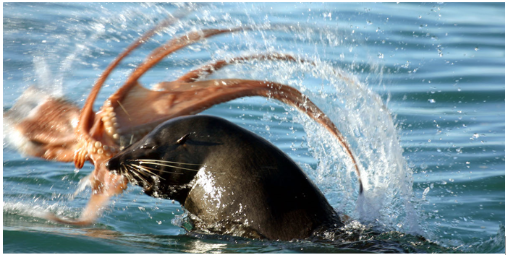
NZ fur seal fishing an octopus (Photo By Leigh Torres)
What is the conservation status of the NZ fur seal?
Their threat status is now least concerned, with a population recovering. However NZ fur seals once were on the brink of extinction (in the 1800’s). When humans arrived in NZ the population was around 2 million but then seals were hunted by Maoris for food and by European for meat and pelts. Since 1978, the NZ fur seal is protected by the Marine Mammals Protection Act. We estimate their current population at around 200,000.
NZ fur seal, a population recovering (Photo by Pohatu Penguins)
What their main threat today?
Despite the Act, human activities are still the main threat to NZ fur seals.
- Fishing industry: Seals are accidentally caught, drown during trawling and long line fishing operations.
- Gas and oil exploration
- Tourism: disturbance or even illegal attacks
- Introduced predators such as dogs
- Pollution: marine debris such as plastic and old nets, oil spills…
- Natural predation : sharks, killer whales (orca), leopard seals and occasionally sea lions
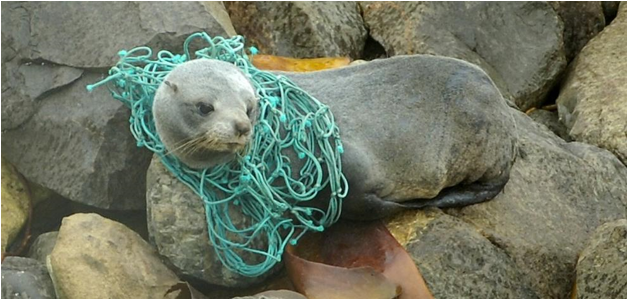
A fur seal caught in a fishing net (Photo by Peter Mc Intosh)
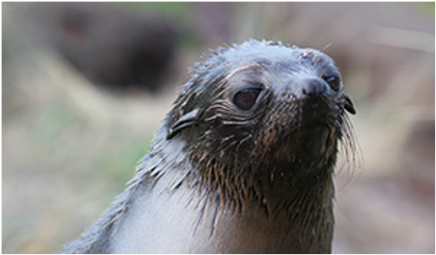
Fur seals are one among many victims of tragic oil spills (Photo by Greenpeace)
What is the size of a NZ fur seal?
Males weigh between 90-150kg and they can measure up to 2.5 meters.
Females are smaller and usually weigh between 30-50-kg and can be 1.5 meters long.
-88.jpg)
A male and his harem (Photo by Pohatu Penguins)
Facts about NZ fur seals:
Diving: NZ fur seals dive longer and further than any other seal. They dive up to 238m (occasionally deeper) for up to 11 minutes.
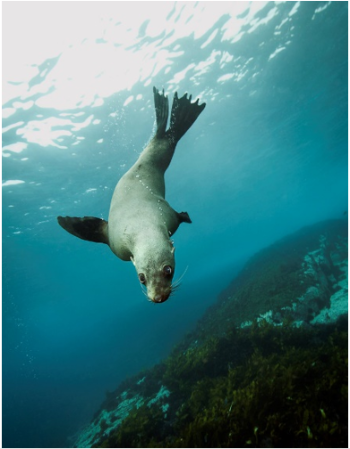
Reproduction: Females have their first pup between 4 and 6 years of age. Every year they give birth to a single pup.
Males are sexually mature at 5 to 6 years old but not socially mature (able to have a territory and sire pups) for another 3 years.
NZ fur seals breed between mid-November and mid-January.
NZ fur seals use a method called delayed implantation to make sure they have their pup during the warm months of summer. The egg is fertilised but only implants in the uterus 3 months later. Gestation is 9 months even though they mated 12 months prior the birth of the pup!
Pups can suckle their mother’s milk for up to 2 years but will start eating solid food before weaning. Once weaned the juveniles need to forage for food by themselves.
The life span of a NZ fur seals is 16 years.
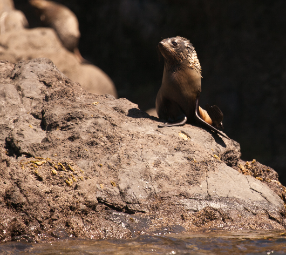
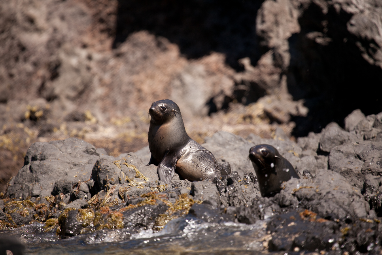
NZ fur seal pups (Photo by Pohatu Penguins)
Can I approach or touch NZ fur seals?
When watching seals, you should always respect these rules :
Stay at least 20 m away
Don’t disturb seals by making loud noises or throwing things
Keep dogs and children away
Don’t feed the seals
Never attempt to move or touch a seal
Never separate a mother and her pup
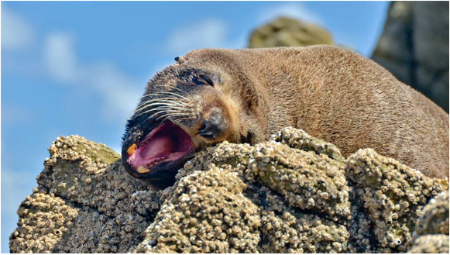
Yawning or not so happy seal telling you to back off? (D.O.C copyright)
What if I’m concerned about a seal’s well-being?
Here is a list of natural behaviours that do not need human intervention. You may see seals:
- looking distressed and scrawny
- sneezing, coughing and with weepy eyes
- drifting in the waves
- flapping flippers as if stranded
- immobile
- fighting
- pups spending time away from their mothers
There are exceptions to our ‘hands off' approach. DOC will intervene if a seal is:
- in notably poor condition
- in immediate danger
- tangled in debris
- causing disruption, like in the middle of a road
- being harassed
If you're concerned then ask yourself: is the seal in danger, injured or being harassed by people or dogs? If so, call our emergency hotline 0800 DOC HOT (0800 362 468)
You need to tell us
- The location of the seal and how to get to it
- The seal species or a description of what it looks like
- What is wrong with the seal
- The state of the tide
- The local weather and sea conditions
- Your contact phone number
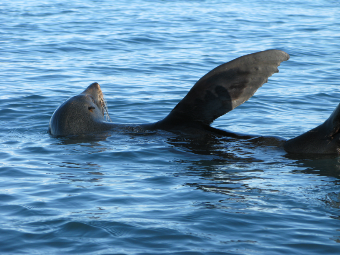
NZ fur seal happily swimming (Photo by Pohatu Penguins)
|
Ideally, we don’t want to handle our penguins at all. However, some of them need our help whether it be from an injury, illness or malnourishment. Pohatu Penguins steps in and gives these little birds a second chance at life! Most of our rehabilitated penguins are underweight or malnourished chicks. Typically, we find these chicks during our tours as we monitor the nesting sites. Why are the chicks malnourished/underweight?
What do you do in rehabilitation? This depends on the penguins needs and condition. Typically we will feed them 2-3 times a day depending on their weight and age. If they are old enough we will bring them for a swim in our “swim therapy pool”. Here, we introduce them to the water and determine if they are ready to be released. Injured or sick penguins will be sent to either a specialized penguin vet or dedicated specialists, Kristina and Thomas*, in Christchurch where they are assessed for future placement. Permanently injured penguins have the chance to live out their lives at the Antarctic Centre. *K&T Link: https://www.stuff.co.nz/environment/88518082/christchurch-couple-give-injured-rescue-penguins-the-full-pamper-treatment ParniaI spotted Parnia while kayaking; she was standing on the rocks looking extremely thin and weak. After getting back onto shore I quickly grabbed a bucket and went on to retrieve her – she gave little resistance to capture. Once I saw her up-close I realized that she had a deformed beak, probably why she had been so thin. (It’s very difficult for penguins to hunt efficiently with a crooked beak, most die.) I had never seen such a thin penguin and I expected her to die within the day, but still it was worth a shot to try and save her. Penguin band: P 41 087One year a starvation event happened right in the middle of the breeding season. When starvation occurs parents stop feeding their chicks to save themselves or only do so periodically. Chicks are then forced to leave (or fledge) the nest early in search of food. Unfortunately, chicks under 8 weeks old are not properly equipped to survive at sea and either starve or drown. In order to prevent early fledgings I fed the chicks while they remained in their burrows, hoping that the starvation event would end soon. Slowly but surely the parents started to return consistently feeding their youngsters and relieving me of my duties! Two years later P41 087 (we used to band our penguins) turned up in one of my breeding boxes. He was one of the largest, most beautiful penguins I had ever seen. P41 087 was evidence that my feedings, two years ago, had been a success. It warmed my heart to know that I helped save this little penguin and build him up for a healthy, successful life in the wild. He was my pride and joy. RoxyRoxy was handed in by the Fox II, a tourist sailing boat in Akaroa. She was extremely thin with a severe injury to her eye. Roxy looked like a recently fledged chick that seemed to have been hit by a boat. Her condition was very grim and I had my doubts about her survival.
However, to my delighted surprise she survived the first 24-hours, then the next and the next, and by day 3 she was on the road to recovery! Her eye injury, however, would be permanent and she would never be able to see from it again. Although, she was doing well in rehabilitation we knew that she wouldn’t stand a chance in the wild, thankfully, Roxy was also sent to the Antarctic Centre where she’ll live out a long and luxurious life! Shark baitThis is an all time favorite story that demonstrates incredible intelligence – intelligence you would never expect from a penguin. One night, while running an Evening Penguin Tour, we found a horribly injured penguin beside the track. I immediately took him into care and the next morning rushed him to Christchurch for an emergency veterinary assessment.. He had several shallow, flesh wounds and a lacerated leg. We suspected the culprit had been a shark. The vet stitched him up and I took him home to recover.. He spent a few weeks with us recovering and eating lots of fish – something he was quite happy to do through his moult*! Once his moult was complete we returned him to the sea and he happily shot off like a rocket! One year later, while running a tour, in the same spot on the tarck out in the open, we found a penguin near the track and out in the open we found a penguin that did move away from us as he should. He also did not attempt to bit and was very relaxed when I picked him up to examine him to find an explanation for this strange behaviour. He was in very good condition, but lame in one leg as Shark bait was when we released him. He proved beyond doubt who we was when I tried to feed him. He snapped and gulp the fish down gleefully and then looked for more, greedy as ever. As he was looking forward to another free easy loading molt we decided to indulged him and sent him on his way, fat and sleek once his feathers were grown in. Once again he shot off, instantly a wild penguin, but we did wonder, would he be back next year for another easy moult*? *Little Penguins moult – loose their old feathers and grow new ones – for two weeks every year. During the moult they cannot hunt and thus starve until it is complete. Yappy WiggleThis was the funniest penguin I’ve ever cared for! One day, while monitoring nesting sites I came across a burrow with one healthy chick and one very small runt. If one chick gets too far behind they simply die and the fouled nest can cause the healthy chick to become sick and die. The best option was to take the runty chick out, but then what to do with it? I decided I would simply throw it in the bushes. It’s very difficult to raise chicks that are less than 2 weeks old, especially if they are runts, but I thought I’d give it a go. Trying to feed such a young chick was not easy, but the little guy responded well and started to put on weight. Soon enough he turned into a healthy, respectable penguin. He became far too tame, however, and ran around like a puppy dog, wiggling his tail and begging for food with sharp, yapping noises. When it came time for him to leave he wasn’t exactly keen. On the first release he returned the next day yapping his way up the drive, begging for more fish. He had obviously not found any for himself. I allowed him to stay for a few days until I figured that we better try again; so, for a second time we released him back into the wild. He returned the very next day for more fish. I fed him once more and came up with a new idea, we’ll release him by kayak! So, in our third release, we took him by kayak to the entrance of Flea Bay and let him go. This seemed to be successful until the fifth day when we saw him hobbling towards the house. This time he was much weaker, thinner and a bit injured. I assumed he had hurt himself along the rocks and barnacles while exiting the sea. After our third try, we realized that Mr. Yappy Wiggle had imprinted on us and would not succeed in the wild. He now happily resides in the Antarctic Centre yapping and wiggling all over the place! Our Christmas Eve SagaBefore you read this you must understand: Yellow Eyed Penguins are the rarest penguin in the world and are extremely endangered. Every single one is precious. One Christmas Eve during a penguin tour we saw one of our Yellow Eyed Penguins drag itself ashore, obviously injured and bleeding. We caught the Yellow Eyed to gauge its injuries in which its feet were badly cut. It looked as though it kicked itself free from the jaws of life and escaped a near death shark attack. It needed stitching as soon as possible if it was to survive, but what vet would be open on Christmas Eve or Christmas Day? Talk about bad timing. I rang our closest vet in Little River and to my surprise he said to bring it straight over. This was 10.00pm on Christmas Eve. We arrived in Little River at 11.30pm, but the vet was nowhere to be seen. We sat there waiting and silently panicking over this precious penguin’s life. Until suddenly a vehicle pulls up with the vet and vet’s family! In order to successfully and painlessly stitch the penguin he needed to be put under. However, this can be dangerous if the penguin has a full stomach – something we weren’t sure about. We simply had to hope for the best and move forward with the procedure. The penguin did not fair well with the gas, he kept drifting in and out of conscious. Then, suddenly he started to heave and projectile vomit fish across the table, the floor and even the walls! Now, you can imagine our surprise, you can also imagine that it was quite unexpected and unfortunately we did not have time to react. So, like the table, the floor and the walls, we too were covered in fish vomit. Merry Christmas indeed! Thankfully after loosing its stomach contents our Yellow Eyed Penguin drifted into sleep and the vet was able to finish the job. With stitched and bandaged feet we placed our groggy penguin back into our vehicle. As we had to get the penguin home our vet and his family had to clean up the fish vomit – lucky them! We bid farewell and wished our Christmas heros a very Merry Christmas. After Christmas I sent the penguin to Christchurch to my wonderful friends and penguin rehab specialists, Christina and Thomas. Once it healed properly we released our Christmas penguin back into the wild. |
 Feeding chicks Feeding chicks Rehabilitated penguins in our garden going for a walk  Swim! (allow the penguins to oil up their feathers)  Releasing an adult.  Two chicks ready to go! (White flippered and Little Blue)  Trying to release Yappy Wiggle.  Still trying to release Yappy Wiggle...  Yellow Eyed Penguin with stitched foot.    |
|
These are just a few of the more memorable birds we have had in care. We rehabilitate many penguins, mostly Little Penguins, sometimes Yellow Eyed and occasionally a Crested Penguin. Most are sent off to sea successfully! If you too wish to help visit our Adopt a penguin page. |


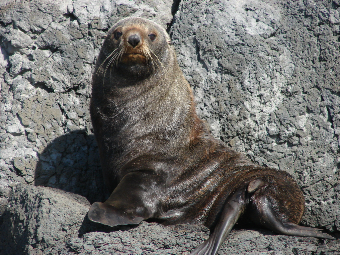
Comments